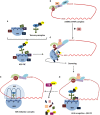Autophagy Regulation by the Translation Machinery and Its Implications in Cancer
- PMID: 32232004
- PMCID: PMC7082396
- DOI: 10.3389/fonc.2020.00322
Autophagy Regulation by the Translation Machinery and Its Implications in Cancer
Abstract
Various metabolic pathways and molecular processes in the cell act intertwined, and dysregulating the interplay between some of them may lead to cancer. It is only recently that defects in the translation process, i.e., the synthesis of proteins by the ribosome using a messenger (m)RNA as a template and translation factors, have begun to gain strong attention as a cause of autophagy dysregulation with effects in different maladies, including cancer. Autophagy is an evolutionarily conserved catabolic process that degrades cytoplasmic elements in lysosomes. It maintains cellular homeostasis and preserves cell viability under various stress conditions, which is crucial for all eukaryotic cells. In this review, we discuss recent advances shedding light on the crosstalk between the translation and the autophagy machineries and its impact on tumorigenesis. We also summarize how this interaction is being the target for novel therapies to treat cancer.
Keywords: ATG; PERK; autophagy; cancer; eIF2alpha; endoplasmic reticulum; mTOR; translation initiation.
Copyright © 2020 Acevo-Rodríguez, Maldonado, Castro-Obregón and Hernández.
Figures





Similar articles
-
Protein kinase RNA-like ER kinase/eukaryotic translation initiation factor 2α pathway attenuates tumor necrosis factor alpha-induced apoptosis in nucleus pulposus cells by activating autophagy.J Cell Physiol. 2019 Jul;234(7):11631-11645. doi: 10.1002/jcp.27820. Epub 2018 Dec 4. J Cell Physiol. 2019. PMID: 30515797
-
The Secret Life of Translation Initiation in Prostate Cancer.Front Genet. 2019 Jan 30;10:14. doi: 10.3389/fgene.2019.00014. eCollection 2019. Front Genet. 2019. PMID: 30761182 Free PMC article. Review.
-
Regulation of autophagy by stress-responsive transcription factors.Semin Cancer Biol. 2013 Oct;23(5):310-22. doi: 10.1016/j.semcancer.2013.05.008. Epub 2013 May 30. Semin Cancer Biol. 2013. PMID: 23726895 Review.
-
Regulation of autophagy gene expression and its implications in cancer.J Cell Sci. 2023 May 15;136(10):jcs260631. doi: 10.1242/jcs.260631. Epub 2023 May 18. J Cell Sci. 2023. PMID: 37199330 Free PMC article. Review.
-
EIF5A mediates autophagy via translation of ATG3.Autophagy. 2018;14(7):1288-1289. doi: 10.1080/15548627.2018.1491213. Epub 2018 Jul 20. Autophagy. 2018. PMID: 29973124 Free PMC article.
Cited by
-
Sarmentosin Induces Autophagy-dependent Apoptosis via Activation of Nrf2 in Hepatocellular Carcinoma.J Clin Transl Hepatol. 2023 Aug 28;11(4):863-876. doi: 10.14218/JCTH.2022.00312. Epub 2023 Jan 31. J Clin Transl Hepatol. 2023. PMID: 37408810 Free PMC article.
-
Regulation of autophagy by non-coding RNAs in gastric cancer.Front Oncol. 2022 Oct 24;12:947332. doi: 10.3389/fonc.2022.947332. eCollection 2022. Front Oncol. 2022. PMID: 36353541 Free PMC article. Review.
-
Regulation of autophagy by microRNAs in human breast cancer.J Biomed Sci. 2021 Mar 25;28(1):21. doi: 10.1186/s12929-021-00715-9. J Biomed Sci. 2021. PMID: 33761957 Free PMC article. Review.
-
Cdc14 spatiotemporally dephosphorylates Atg13 to activate autophagy during meiotic divisions.J Cell Biol. 2022 May 2;221(5):e202107151. doi: 10.1083/jcb.202107151. Epub 2022 Mar 3. J Cell Biol. 2022. PMID: 35238874 Free PMC article.
-
Crosstalk between m6A modification and autophagy in cancer.Cell Biosci. 2024 Apr 4;14(1):44. doi: 10.1186/s13578-024-01225-5. Cell Biosci. 2024. PMID: 38576024 Free PMC article. Review.
References
-
- Hernández G, Tettweiler G. Protein abundance variation. In: Meyer RA, editor. Systems Biology. Weinheim: Wiley-Blackwell; (2012). p. 117–37. 10.1002/3527600906.mcb.201100039 - DOI
Publication types
LinkOut - more resources
Full Text Sources
Miscellaneous

